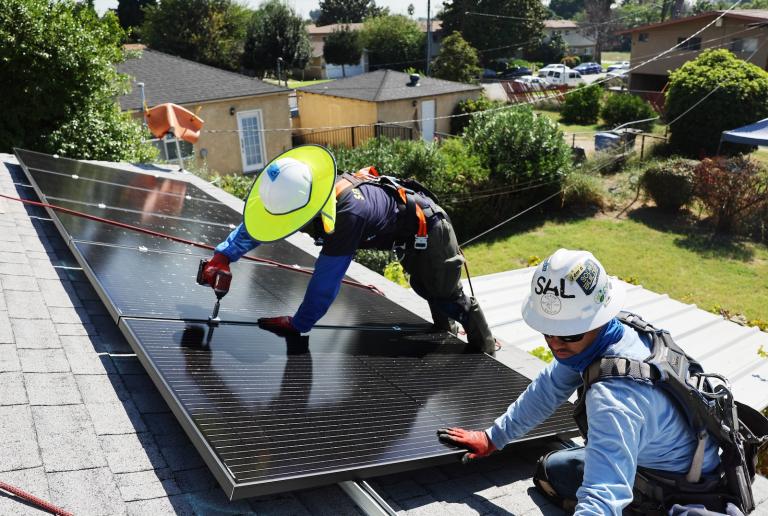Democrats on the House Energy and Commerce Committee next week will begin debating one of the most critical pieces of the Waxman-Markey climate bill: how the government will distribute the emissions permits, and the corresponding “allowance value,” under a cap and trade program for greenhouse gases. The formula Congress arrives at will be key to managing consumer costs.
As events unfold over the next few weeks, here are a few things to keep in mind:
40 Percent to Consumers. A group of key swing Democrats have requested that 40 percent of the allowances initially be given for free to the utility sector as proposed by the U.S Climate Action Partnership. It’s important to note that this is not a free allocation to the polluters – i.e. electricity generators. Instead, this approach essentially puts the allowance value in consumers’ pockets by distributing permits at no charge to the local utilities that provide electricity and natural gas to American households. Those “local distribution companies” (LDCs) are regulated by public utility commissions, who would be able to ensure that the utilities pass the value along to consumers. Consumer advocates like Sonny Popowsky, the Consumer Advocate for Pennsylvania and a founding member of the National Association of State Utility Consumer Advocates, see the merits of this approach. At the bottom of this post is a must-read excerpt from his testimony to the Energy and Commerce Committee a few weeks ago. An excellent explanation of the LDC approach is also available on USCAP’s website .
It’s About the Value – Not the Mechanism. The total number of allowances represents trillions of dollars in value over the life of a cap and trade program. That’s true regardless of whether the permits are auctioned or allocated for free. Permits that are auctioned generate revenue that the government can distribute to ease the transition to a low-carbon economy, and permits that are distributed for free are an asset that can be used to ease the transition just the same. Either way, Congress can and should ensure that a sufficient amount of that allowance value is used to protect consumers and help manage transition costs.
About Dime a Day. A well-designed cap and trade system that gives a percentage of allowance value to consumers can be implemented at a low cost to American households. How low? According to a new EPA analysis of the Waxman-Markey climate bill (the American Clean Energy and Security Act), an ambitious cap on carbon pollution can be met for as little as $98 per household per year – or about a dime a day per person.
In the early years the costs are even lower: Before 2012 it is zero — because the bill won’t have taken affect. By 2015, the costs “skyrocket” to 2 cents per person. Anyone who claims that now is the wrong time to cap carbon is engaging in scare tactics. EPA’s analysis sets the gold standard by using two of the most credible, transparent, and peer-reviewed economic models available. It’s not a crystal ball, but it shows clearly that household costs will be modest if a percentage allowance value is returned to consumers. That’s the same message that emerges from a range of objective economic studies of a cap on carbon, as we found in a report last year assessing the best analyses from government and academia.
So why do some opponents keep saying it will cost thousands? Either they are ignoring every credible analysis of cap and trade legislation, or they’re very bad at math. If they cite a study claiming astronomical costs, be sure to check: (1) who funded the study, (2) if the authors actually agree with the claims about their study – one MIT study was distorted by a factor of 30, according to its authors, and (3) if it was a study of the current bill.
Here’s the excerpt from Sonny Popowsky’s testimony to the House Energy and Commerce Committee: “This discussion brings me back to the NASUCA 2007 Resolution, which supports Congressional action to reduce carbon emissions, but urges that it be done in a manner that minimizes the cost to consumers and does not produce windfall gains to electric generators. The key to approaching these goals is to ensure that emission allowances are allocated properly and that proceeds from any sale of these allowances should be flowed back to the benefit of the electric consumers who are bearing the cost of this program.
“First, it should be clear that allowances must not be allocated at no cost to deregulated generators, who will turn around and charge us for them anyway. To the extent that allowances are to be given at no cost to any segment of the utility industry, those allowances should be given to the regulated local distribution companies, or LDCs. To the extent that LDCs are paid by generators for the purchase of those allowances, then, in my view, the proceeds must be flowed back to ratepayers through such means as customer rebates, energy efficiency programs, and low-income energy assistance. Just as it would be inappropriate to give unregulated generators the proceeds from the sale or use of free allowances, so too would it be inappropriate to provide this money to electric distribution utilities for purposes other than to benefit their respective ratepayers. The key point is that all electric distribution utilities in the United States are either regulated by state commissions (in the case of investor-owned utilities), or are customer-or publicly owned (in the case of co-ops and municipal and public power companies). As a result, there are reasonable mechanisms in place to ensure that the benefits of any free allowances will go to consumers.”

